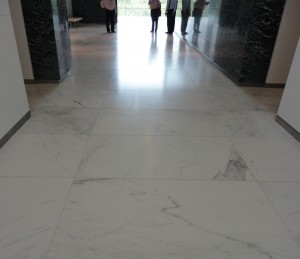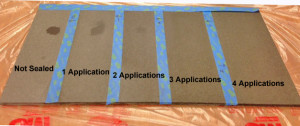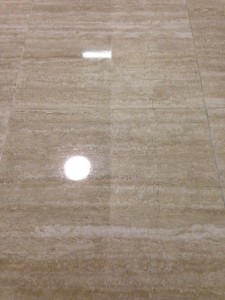When we polish marbles and granites, we can almost make the surface look like glass. It really is very beautiful, but what if you like the more rustic look? And what if you intend to place marble or granite in a high foot traffic area. That’s when we suggest a honed finish over a polished finish.
In fact, we’ve seen a lot of marble kitchen countertops and granite lobby floors with a flat, honed finish lately.
What exactly is a honed finish on natural stone? The Marble Institute of America states that “honing is a process that removes scratches on stone surfaces, as well as etches from acid or heavy alkaline damage…This process is also done by machine with diamond abrasive pads or honing compounds and water and creates no dust.”
Ok now that we have the technical part out of the way, I would describe a honed finish as a stone surface that does not have a high polish. A honed finish can be a completely flat finish, or can have a bit of a sheen, or a patina finish.

What are the benefits of having a honed finish on natural stone?
If you have honed white marble countertops, and you spill something acidic like vinegar on the marble, the etch mark will show a little less compared to a marble surface with a high polished finish. Etch marks remove the shine from the surface of the stone, so the lower the shine, the harder it is to see the etch marks.
For buildings, wear patterns and traffic areas also show a little less compared to a lobby floor with a high gloss finish. Please keep in mind that both honed stones and polished stones need maintenance, but with a honed finish, wear patterns may be a little less visible to the untrained eye.

What issues might you have with a honed finish on natural stone?
The more honed a stone surface is, the more open the pores are; meaning that stones with a honed finish may absorb liquids more than a stone with a polished finish. For example, a honed black granite floor can absorb liquids such as oil and grease faster than a polished black granite floor.
One way to help this problem: make sure you seal your stone at least annually with a penetrating sealer such as Seal & Go® S. According to the Marble Institute of America, sealing makes “a veneer joint watertight with an elastic adhesive compound” and “application of a treatment delays staining.”

One more point to consider: if you have a completely flat (no polish at all) honed finish that has a little texture, you may have to clean embedded dirt on a regular basis. You can use a soft bristle scrub brush and a neutral cleaner such as Lavenet or Lavenet Green. If you would like to learn more about cleaning embedded dirt from textured surfaces, please read “How to Clean Textured Stones and Tiles.”
Whether you like a polished stone finish or a honed stone finish, there are no right or wrong choices. They both have their pros and cons and they are both beautiful in their own way.

